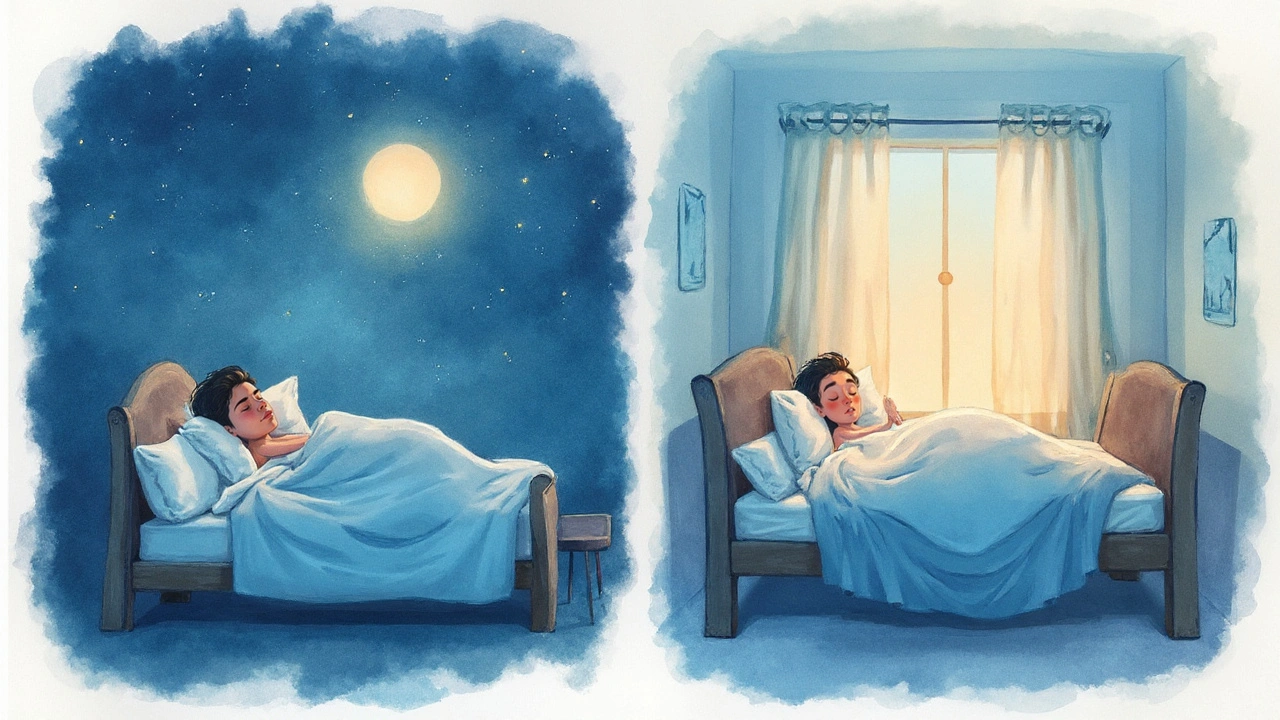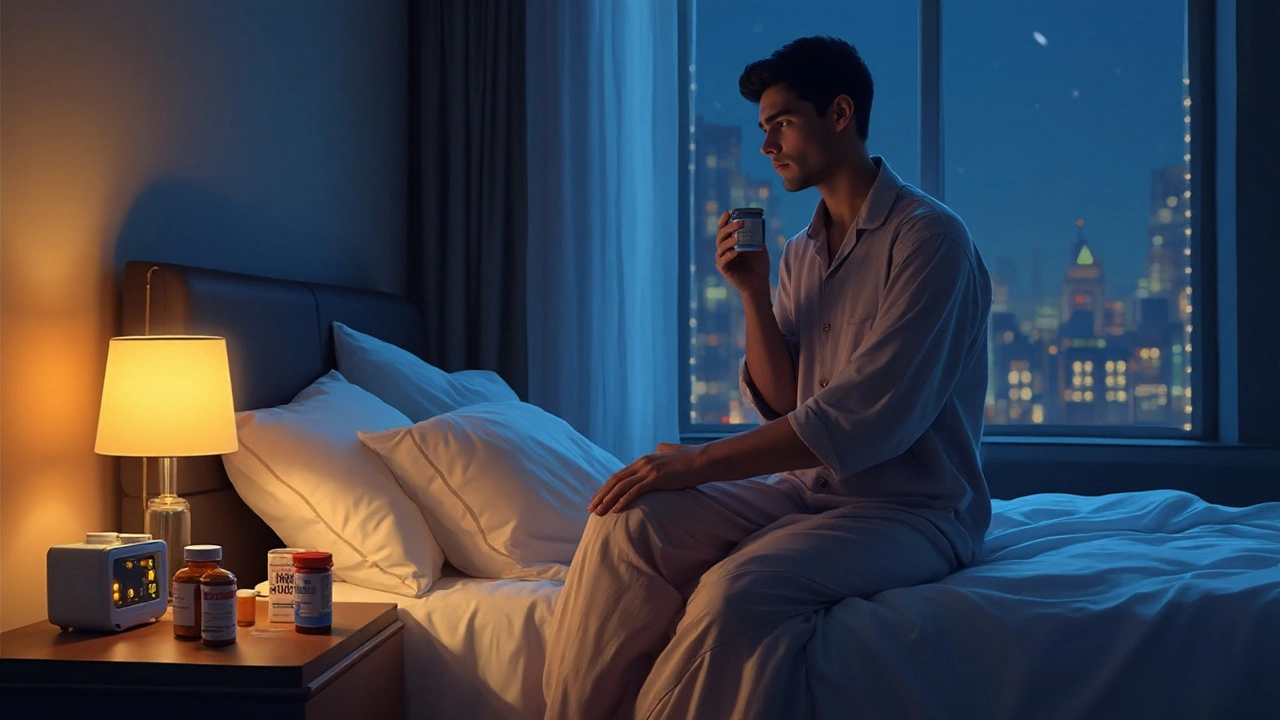Sleep Aid Selector Quiz
Answer the questions to see which sleep aid may fit your needs.
Sinequan (doxepin) is a low‑dose tricyclic antidepressant approved for chronic insomnia. It works by blocking histamine H1 receptors, which quiets the brain’s wake‑up signals. Many patients turn to Sinequan when classic hypnotics cause next‑day grogginess or when they also need an antidepressant effect. But the market is crowded - there are plenty of Sinequan alternatives that promise similar sleep benefits with different safety profiles. This guide walks you through the most popular options, their core attributes, and how to pick the right one for your night‑time routine.
Why Sinequan is Used for Insomnia
Although doxepin was first launched in the 1960s as a mood‑stabiliser, the low‑dose formulation (3‑6mg) gained FDA approval in 2010 for treating sleep maintenance insomnia. The key features are:
- Strong antihistamine action that reduces nocturnal awakenings.
- Minimal anticholinergic activity at low doses, lowering the risk of dry mouth and constipation.
- Long half‑life (≈9-15hours) that sustains sleep without a morning “hang‑over”.
Typical prescribing guidelines suggest taking the tablet 30minutes before bedtime, on an empty stomach. Because the drug is metabolised by CYP2D6, clinicians check for drug‑drug interactions, especially with SSRIs or beta‑blockers.
Who Might Consider Sinequan?
Ideal candidates are adults over 18 who:
- Struggle with staying asleep rather than falling asleep.
- Have tried first‑line non‑pharmacologic approaches (sleep hygiene, CBT‑I) with limited success.
- Need an agent that does not cause severe daytime sedation.
It’s not recommended for pregnant or breastfeeding women, nor for patients with severe cardiac conduction disorders, as doxepin can prolong the QT interval.
Alternative Sleep Aids - Quick Overview
The landscape of insomnia medication includes both prescription hypnotics and over‑the‑counter (OTC) supplements. Below are the most frequently compared options:
- Trazodone - a serotonin antagonist and reuptake inhibitor (SARI) often prescribed off‑label for sleep.
- Mirtazapine - a noradrenergic and specific serotonergic antidepressant (NaSSA) with strong antihistamine effects at low doses.
- Zolpidem - a non‑benzodiazepine hypnotic (Z‑drug) that binds to the GABA‑A receptor.
- Diphenhydramine - an OTC antihistamine commonly found in night‑time sleep aids.
- Melatonin - a naturally occurring hormone that regulates circadian rhythm.
- Ramelteon - a melatonin‑receptor agonist approved for sleep onset insomnia.
Each alternative brings its own balance of efficacy, side‑effects, and cost. The following sections dive into the details.
Trazodone - The Sleep‑Friendly Antidepressant
Trazodone is a serotonin antagonist and reuptake inhibitor (SARI) originally launched for depression in 1981. At doses of 50‑100mg, it produces sedation by blocking histamine receptors and inhibiting serotonin reuptake. Key points:
- Effective for patients with comorbid depression and insomnia.
- Lower risk of dependence compared with benzodiazepines.
- Common side‑effects: morning grogginess, orthostatic hypotension, rare priapism.
Because trazodone’s half‑life is about 5‑9hours, a higher dose may cause next‑day sleepiness, so clinicians often start at 25mg and titrate up.
Mirtazapine - Dual Antidepressant‑Sedative
Mirtazapine is a NaSSA that blocks α2‑adrenergic receptors and H1 histamine receptors. Doses of 7.5‑15mg are frequently used off‑label for insomnia. Highlights:
- Very potent antihistamine effect leads to deep, restorative sleep.
- Weight gain and increased appetite are common - a drawback for some.
- Can improve mood and anxiety, making it a good choice for patients needing both.
Its half‑life (≈30hours) means drug accumulation; patients should be warned about prolonged sedation if taken later in the evening.
Zolpidem - Classic Non‑Benzodiazepine Hypnotic
Zolpidem is a short‑acting GABA‑A modulator marketed under names like Ambien. It’s the go‑to prescription for short‑term (<4weeks) sleep‑onset insomnia. Core attributes:
- Rapid onset (within 15minutes) and 2‑hour half‑life, ideal for falling asleep.
- Risk of complex sleep‑related behaviours (sleep‑walking, sleep‑driving).
- Potential for next‑day cognitive impairment at higher doses.
Guidelines now recommend the lowest effective dose (5mg for women, 5‑10mg for men) to minimise adverse effects.

Diphenhydramine - The OTC Antihistamine Shortcut
Diphenhydramine is an H1‑blocking antihistamine found in products like Nytol. It’s inexpensive and readily available, but it comes with a trade‑off.
- Effective for occasional sleeplessness, especially in older adults.
- Strong anticholinergic activity can cause dry mouth, urinary retention, and blurred vision.
- Tolerance develops quickly - effectiveness wanes after a few weeks.
Because of its short half‑life (≈4‑6hours), next‑day sedation is usually minimal, but the anticholinergic burden is a concern for patients on multiple meds.
Melatonin - Aligning the Body Clock
Melatonin is a hormone secreted by the pineal gland that signals darkness to the brain. Supplemental melatonin (0.5‑5mg) is popular for jet lag, shift work, and mild insomnia.
- Helps regulate circadian rhythm rather than sedate directly.
- Very safe; side‑effects are limited to mild headaches or daytime drowsiness.
- Effectiveness varies - works best when bedtime is consistent.
Because melatonin is a dietary supplement, product quality can vary; look for pharmaceutical‑grade preparations.
Ramelteon - Targeted Melatonin‑Receptor Agonist
Ramelteon is a selective MT1/MT2 receptor agonist approved for sleep‑onset insomnia. Unlike melatonin, it binds directly to receptors, offering a more predictable effect.
- No known abuse potential; safe for long‑term use.
- Minimal next‑day sedation; suitable for people who need to stay alert.
- Cost is higher than OTC melatonin and not covered by most insurers.
Typical dosing is 8mg taken 30minutes before bedtime.
Side‑Effect and Interaction Snapshot
| Medication | Primary Mechanism | Typical Dose for Insomnia | Half‑Life (hrs) | Main Side‑Effects |
|---|---|---|---|---|
| Sinequan (doxepin) | H1 antihistamine (low‑dose tricyclic) | 3‑6mg | 9‑15 | Dry mouth, constipation, rare QT prolongation |
| Trazodone | SARI - serotonin antagonist + reuptake inhibition | 50‑100mg | 5‑9 | Morning grogginess, orthostatic hypotension, priapism (rare) |
| Mirtazapine | NaSSA - α2‑blockade + H1 antagonism | 7.5‑15mg | 30 | Weight gain, increased appetite, sedation |
| Zolpidem | GABA‑A agonist (Z‑drug) | 5‑10mg | 2‑3 | Complex sleep behaviours, next‑day drowsiness |
| Diphenhydramine | First‑generation H1 antihistamine | 25‑50mg | 4‑6 | Anticholinergic load, tolerance, dry mouth |
| Melatonin | Endogenous hormone supplement | 0.5‑5mg | 0.5‑1 | Headache, mild daytime drowsiness |
| Ramelteon | MT1/MT2 receptor agonist | 8mg | 1‑2 | Rare dizziness, cost considerations |
Decision Guide - Which Option Fits Your Situation?
Think of your insomnia as a puzzle. The picture you’re trying to complete includes three main pieces: the underlying cause, safety profile, and lifestyle constraints.
- Primary insomnia with no depression: Melatonin or Ramelteon are first‑line because they target the circadian system without heavy sedation.
- Sleep maintenance problems and mild depression: Low‑dose Sinequan or Mirtazapine can kill two birds with one stone - they improve mood and keep you asleep.
- Short‑term acute insomnia (e.g., after a stressful event): Zolpidem provides fast onset but should be limited to a few weeks.
- Budget‑conscious, occasional sleeplessness: Diphenhydramine or OTC melatonin work well, as long as you accept the tolerance issue.
- Complex medical regimens with CYP2D6 inhibitors: Avoid Sinequan and Triazodone; consider Ramelteon or low‑dose Mirtazapine (which uses different pathways).
Always discuss liver and kidney function with your prescriber, as many of these agents are metabolised hepatically.
Related Concepts Worth Exploring
Understanding the broader sleep health context helps you make smarter drug choices. Topics that naturally follow include:
- Sleep hygiene: environment, blue‑light exposure, caffeine timing.
- Cognitive‑behavioral therapy for insomnia (CBT‑I): the gold‑standard non‑pharmacologic treatment.
- Depression‑related insomnia: how mood disorders alter sleep architecture.
- Polypharmacy risks: strategies to avoid drug‑drug interactions in older adults.
Delving into these areas will give you a fuller picture of why a medication works-or doesn’t-in your unique case.
Next Steps & Troubleshooting
If you start a new sleep aid, keep a simple sleep diary for two weeks. Record:
- Bedtime and wake‑time.
- Number and duration of night‑time awakenings.
- Daytime alertness (rating 1‑5).
- Any side‑effects you notice.
Share the diary with your clinician. If you experience persistent morning grogginess, consider lowering the dose or switching to a shorter‑acting agent like Ramelteon. For worsening depression while on a sleep aid, a medication with dual antidepressant activity (e.g., Mirtazapine) may be preferable.

Frequently Asked Questions
Can I take Sinequan and melatonin together?
Yes, most clinicians consider it safe because melatonin works on a different pathway (MT receptors) and isn’t metabolised by CYP2D6. However, start melatonin at a low dose (0.5‑1mg) and monitor for excessive daytime sleepiness.
Why does my doctor suggest a low‑dose tricyclic instead of a Z‑drug?
Low‑dose tricyclics like Sinequan have a much longer safety record for chronic sleep maintenance and carry a lower risk of complex sleep behaviours. Z‑drugs are great for short‑term onset issues but can lead to dependence if used beyond a few weeks.
Is diphenhydramine safe for older adults?
It’s generally discouraged for people over 65 because anticholinergic side‑effects (confusion, urinary retention) increase fall risk. Safer options include low‑dose Sinequan or melatonin.
How long does it take for ramelteon to work?
Ramelteon reaches peak plasma levels within 30‑60minutes, so most patients notice an improvement in sleep onset that night. Consistent use helps stabilize the circadian rhythm over a few weeks.
What should I do if I wake up feeling groggy after taking trazodone?
Try lowering the dose to 25mg or switching to a shorter‑acting agent like ramelteon. Also, ensure you take trazodone 30minutes before bed and avoid alcohol, which can amplify sedative effects.


Ben Muncie
September 24, 2025 AT 20:57Using prescription sleep pills when an OTC option works is just irresponsible.
kevin tarp
September 27, 2025 AT 10:51The low‑dose formulation of doxepin (3‑6 mg) is specifically FDA‑approved for sleep maintenance, and it should be taken 30 minutes before bedtime on an empty stomach.
ravi kumar
September 30, 2025 AT 00:44India has a long history of using herbal sedatives, yet the modern market pushes synthetic agents like Sinequan without enough local awareness. Many patients assume that a prescription automatically means safety, ignoring the QT‑prolongation risk that can be fatal. The cost of doxepin in our pharmacies is also higher than that of melatonin, which is widely available over the counter. Moreover, we must consider drug interactions with common antihypertensives prescribed here. A balanced approach that respects traditional remedies while scrutinizing new pharmaceuticals is essential for public health.
SandraAnn Clark
October 2, 2025 AT 14:38Sleep is a basic need, not a luxury.
Rex Wang
October 5, 2025 AT 04:32Honestly, the guide does a solid job covering the options, but remember, everyone’s reaction varies, so you might need to experiment, and don’t forget to prioritize good sleep hygiene, because pills are just a backup, not a cure.
mark Lapardin
October 7, 2025 AT 18:25From a pharmacokinetic perspective, doxepin’s CYP2D6 metabolism profile necessitates genotype‑guided dosing to mitigate adverse events, especially when co‑administered with SSRIs that act as strong inhibitors. The high affinity for H1 receptors confers its anti‑insomnia properties, yet the marginal anticholinergic load at 3 mg differentiates it from classic TCA toxicity. Comparative efficacy trials demonstrate a modest improvement in wake after sleep onset (WASO) relative to zolpidem, albeit with a more favorable next‑day alertness score. Clinicians should therefore weigh the benefit–risk ratio individually.
Barry Singleton
October 10, 2025 AT 08:19When you stack the side‑effect profile against the marginal gain in total sleep time, Sinequan looks like a marginally better bet than diphenhydramine, but nothing beats a disciplined CBT‑I regimen. The data still show a 0.3‑hour increase on average, which is statistically significant but clinically modest. Also, the cost‑effectiveness analysis falls flat when you factor in routine ECG monitoring for QT issues.
Javier Garcia
October 12, 2025 AT 22:13Melatonin remains the safest first‑line supplement for circadian rhythm disorders.
christian quituisaca
October 15, 2025 AT 12:07Hey everyone! If you’ve never tried a low‑dose antihistamine for sleep, Sinequan can be a game‑changer, especially when you’re also battling anxiety. Just make sure you chat with your doctor about any heart meds you’re on, and keep a sleep diary to track real progress.
Donnella Creppel
October 18, 2025 AT 02:00Wow!!! This article totally redefines the very essence of nocturnal tranquility-doesn’t it just make you feel like you’re floating on a cloud of pharmacological wonder??? I mean, who even needs melatonin when you’ve got Sinequan, right???
Jarod Wooden
October 20, 2025 AT 15:54The pursuit of sleep is, in essence, a rebellion against the tyranny of wakefulness; therefore, employing a drug like doxepin is not merely a clinical decision but an existential statement, a declaration that one refuses to be shackled by the fleeting whims of the circadian clock.
lee charlie
October 23, 2025 AT 05:48It's a bold view but remember the side effects.
Greg DiMedio
October 25, 2025 AT 19:41Oh great, another "miracle" pill that will totally fix my insomnia overnight.
Badal Patel
October 28, 2025 AT 09:35Esteemed colleagues, it is incumbent upon us to scrutinize the pharmacological armamentarium with the rigor befitting our noble vocation. The low‑dose tricyclic doxepin, herein designated Sinequan, proffers a salutary effect upon nocturnal awakenings through potent H1 antagonism, whilst eschewing the deleterious anticholinergic burden characteristic of its progenitors. Yet one must not disregard the imperative of cardiac surveillance, for QTc prolongation looms as an insidious adversary. In juxtaposition, melatonin, the endogenous chronobiotic, enjoys an enviable safety profile, albeit with modest efficacy in isolated sleep maintenance insomnia. Thus, a prudent clinician shall weigh-yea, weigh-the merited benefits against potential perils before consigning Sinequan to the therapeutic repertoire.
KIRAN nadarla
October 30, 2025 AT 23:29The exposition astutely highlights both efficacy and cardiotoxic risk; however, the assertion that melatonin's efficacy is merely "modest" neglects recent meta‑analyses indicating statistically significant reductions in sleep onset latency for circadian rhythm disorders. A balanced appraisal would incorporate dosage stratification and patient heterogeneity.
Kara Guilbert
November 2, 2025 AT 13:22Its not oky to pop a prescrption drug when natural options are out there.
Sonia Michelle
November 5, 2025 AT 03:16Sleep, in many ways, is the silent therapist of our minds; it restores, rejuvenates, and often reveals the truths we shy away from during our waking hours. Choosing a sleep aid should therefore be guided not only by pharmacology but by a mindful consideration of how we wish to engage with our own inner narratives.
Neil Collette
November 7, 2025 AT 17:10Oh, how profound, you’ve turned a bedtime supplement guide into a séance for the soul. Let’s all gather around the candlelit altar of Sinequan and chant the mantra of ‘I am enlightened by my insomnia.’ Because obviously, a pharmacological H1 blocker can solve the existential dread that keeps us up at 3 a.m. Your poetic musings about sleep as a therapist ignore the cold, hard fact that doxepin can still cause QT prolongation. People don’t need another essay on the metaphysics of dreaming; they need clear guidance on dosage. Yet you sprinkle your words with vague platitudes, as if they’ll magically convert skeptics. Do you really think a doctor will prescribe a drug based on a Reddit‑style sermon? The reality is that most of us are looking for a cheap, effective fix, not a lecture on the meaning of consciousness. Your friendly tone masks the very real risk of daytime sedation and anticholinergic side effects. Moreover, the claim that melatonin is ‘natural’ is a marketing myth that ignores its synthetic production. If you truly cared about patient safety, you would prioritize evidence‑based dosing charts over lyrical fluff. Instead, you drown the reader in flowery language, wasting the precious few minutes people have before they try to fall asleep. Sarcasm aside, the guide could benefit from a straightforward table comparing half‑lives, onset times, and contraindications. That would be a far more responsible contribution than dubbing Sinequan a ‘silent therapist.’ So please, let’s return to facts, keep the drama on stage, and give readers the clear info they deserve.
James Lee
November 10, 2025 AT 07:03i guess any drug works if u ditch your bedtime routine.
Dennis Scholing
November 12, 2025 AT 20:57While the sentiment underscores the importance of sleep hygiene, empirical evidence consistently demonstrates that behavioral interventions alone frequently yield superior outcomes compared to pharmacotherapy in isolation.